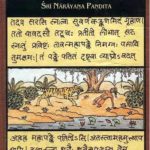Subsequent to our previous article is a topic that is all-too relevant to both Raajadharma and the times. The Kali Age is not just an age of admixture but an age of confusion. When everybody knows what position to play, then society functions as an organic whole (rather than a series of selfish, silo’d koopastha mandukas). Instead today we have individuals playing with history and dharma so that they can justify adharmic proxy rule. But as Raajadharma stipulates, it is the king who rules, and not his ministers or advisors. That is the relevance of the ancient text known as Nitiprakasika.
Neethiprakaasika expounds Dhanurveda amidst upadesa on Raajadharma because he who wields the weapon of power is the one who rules. Thus the martial class is the one that rules, and the Raaja who is the head of society. Brahmanas are the mouth as they chant Vedas, common Kshatriyas are the arms as they wield arms, Vaisyas are the thighs whose motion generates wealth, and Sudras are the feet for their productive foundation. But the Raaja is the head of all of these, governs them, plans on their behalf, and directs them. Dharma is sovereign and Purusa is the embodiment of Dharma. The Raaja must therefore govern in accordance with Purusa and Prakrti.
However, in Bharat Ganaraajya, this message has been forgotten amidst asuric ideologies. In contrast to the short-sighted “Chanakya Neethi!!” of today, study of the Nitiprakasika is consonant with the Raajadharma Anusaasana Parva of the Mahabharata. This is no surprise as unlike Chaanakya, the author was an actual Rishi.
Author
Maharishi Vaishampaayana is one of the illustrious students of Maharishi Veda Vyasa. Vyaasa was the compiler of the Vedas, and divided them into the form we have today. Rg Veda was given to Paila, Saama was given to Jaimini, Atharvana was given to Sumanthu. Vaisampaayana received the Yajur Veda from his Guru, and subsequently taught Nitisastra at his behest. [1, 23] Mention of him can be found in many of scriptures and even slokas. It is, after all, Vaishampaayana who narrates the Mahabharata to Maharaaja Pareeksit. Fittingly, the same Rishi narrates the Nitiprakaasika to the son of Pareeksit: Janamejaya.
The narration begins by describing the arrival of Vaishampaayana to the great city of Takshaseela. Known today as Taxila, this fabled nagari of old was in the domain of the great-grandchild of the Pandavas. And it was here that the venerable Vaishampaayana explained Rajadharma to King of the Kurus. Unlike Chaanakya, this real Rishi did not linger to rule-by-proxy, but returned to his ashram after educating the Raaja.
The only job of a Brahmin is to study and chant Vedas and then to teach Vedas to others. He should not earn money.#Periyava
— Sage of Kanchi (@haraharasankara) January 17, 2017
The true Acharya and Guru know his role and does not seek to exceed it, and as a true Brahmana, he rejects material life and lives on the alms and grants of society.
Poverty and non-possession of anything more than the minimum essential requirements are the defining characteristics of a true Brahmin, as per Sastras.#Periyava
— Sage of Kanchi (@haraharasankara) January 16, 2018
As such, the time has come to put Chaanakyanism aside, and learn from a true Acharya, the venerable Vaishampayana Muni, who instructed Maharaaja Janamejaya in Raajadharma and Dhanurveda.
“NP opens with Vaisampayana’s visit to Janamejaya on his own accord at Taksasila. On receiving the news of the arrival of the sage he set out with his ministers and priests to meet him. After the usual ceremonial offerings Janamejaya adjourned to another room for a personal meeting with the sage. Here the king referred to the depravities of the Kaliyuga leading to the deterioration of morality, righteousness, shift of emphasis on wealth and other evil effects in detail (NP 1.11-17).” [1, 42]
“Consequently Janamejaya, with a lot of concern, asks about how to handle the above situation effectively through DV, that is, through military training and organization and the practice of arms both during peace and war as part of his kingly duties. Vaisampayana responds with satisfaction revealing that the exposition of the same was the motive of his visit at present. This request is essential as per the tradition requiring the expression of the keen desire of the pupil to have knowledge through a request to the preceptor.” [1, 42]
Composition
The Neethisprakaasika of Vaishampaayana is a Sanskrit text and comes down to us in 2 recensions: one in Telugu script and another in Grantha lipi. The former was found with a commentary called Tattva vivrti by a Pandit named Seetharaama of Kaundinyasa gotra. [1, 3] Neethiprakaasika is a work composed in 8 cantos. Conceptually it appropriately commences with Raajadharma, then discusses the origin of Raajasaastra, then proceeds into Dhanurveda, before returning to Raajadharma.
Thus, long before the Arthasastra, the correct named for the science of Statecraft was Raajasaastra. It originates with Vidhaatha (Brahma Dev) himself. As the Maharishi relates, Brahma Pitamaha instructs Raaja Prthu in Raajadharma and Dhanurveda. This is because one naturally necessitates the other. Raajadharma requires Dhanurveda for Danda, and Dhanurveda requires Raajadharma for Dharma.
“Thus we find that six out of eight cantos are totally devoted to DV or military art and science, with the aim being to control the deteriorated dharma or ethical and moral values prevailing in the society due to Kaliyuga (NP 1.10-18). Therefore the instruction on the DV as an indispensable part of polity—rajaniti/rajadharma/rajasastra—makes NP a primary text of DV.” [1, 37]
Thus, he who rules must wield the blade or the bow. “DV or military organization and administration come under the scope of the kingly duties or raajadharma referring to the maintenance of law, order, prosperity and welfare of the state, and thus make the king an ideal leader of an ideal state.” [1, 37]
Rajadharma (governance) is at the confluence of Neethisaastra and Dharmasaastra. The distinction is that Niti is focused on the practical amoral aspects, while Dharma exhorts the actualisation of noble principles for society. The Neethiprakaasika, therefore, delineates what must pragmatically be done in the Kali Age, to maintain Dharma.
The lineage of Raajasaastra is discussed at length. It is said to have originated with Brahma who composed 100,000 chapters on the topic. This was condensed by Rudra to 50,000. Skanda, the deva of war, consolidated it to 25,000. Indra followed with 12,000, then Praacetasa Manu with 6,000. Brhaspathi famously composed his Arthasaastra in 3,000. He was followed by Sukra with 1,000. Bharadvaja followed suit with 4,000 and Gaurashira with 500. Veda Vyaasa reduced this to 300 chapters, and Vaishampaayana to 6. [1, 208]
The First Canto is focuses on Raajadharma, and so titled Raajadharmopadesa
The Second Canto introduces Dhanurveda, and so titled Dhanurvedavivekakathanam
The Third Canto is called Khadgotpattikathanam, and narrates the Sword’s Origin
The Fourth Canto focuses on Weapons that are released, Muktaayudhniroopanam
The Fifth Canto delineates Non-released Weapons, Amuktaayudhniroopanam
The Sixth Canto discusses leading an Army to War, Senaanayanakathanam
The Seventh Canto is on Sainyayogakathanam, Administration of the Army
The Eighth Canto is on Raajavyaapaarakathanam, Description of King’s duties
“Thus, the first and the eighth cantos directly focus on the king’s duties and the activities related to the governance. The other cantos deal with the weaponry and military activities, and are thus related to the science of warfare forming a part of Raajadharma requested by Janamejaya.” [1, 41] It is appropriate that Maharishi Vaishampaayana is the one who imparts knowledge of Dhanurveda to the scion of the Pandavas, as Dhanur Veda is the upaveda of the Yajur Veda. Though often conflated, Dhanur Veda is distinct from Dhanur Vidya, which is the study of Archery. Dhanur Veda is the Art of Warfare.

Interestingly, a critical point lost on medieval Indian generals was asserted. “As the leader of the nation, and therefore, of the entire army, it forms an integral part of a king’s neeti as well as duty to hold the strategic place devoid of danger which is coveted by heroes and fight the enemies.” [1, 72] Rather than an all or nothing fight-or-flight, a strategic approach to battlefield operations is seen: “War is a gamble depending on destiny, as often the perfect plans come to be foiled within a moment and tables turn. Hence, in case the army flees, the king has to hold the ground by stopping it with the army corps, which is called mundanika. By controlling the situation thus, the king should consecrate the arms and new ensigns and march out; thus he can defeat the enemies (NP 6.86)“. [1, 72] What’s more, in case the leader falls, there is clear stipulation of the importance of chain-of-command.
Koota Yuddha is also discussed, in contrast to Prakaasa Yuddha. The lessons of the Kurukshetra War were not lost on Acharyas, and night attacks are also discussed as part of deceptive warfare practiced in the Kali Age.
From a weapons perspective, a number of suhstras (aayudhas) are mentioned. While the standard arsenal is listed (dhanush (bow), kunta (spear), gadha (mace), etc), there are 2 standouts. 1 is mention of a boomerang type weapon. This is called Aastara, and was useful against mahouts and foot soldiers. [1, 56] The other, and more famous one, is the Asi (sword). Interestingly, the dagger (asidhenu) is mentioned as the daughter of the sword. While the asi is no surprise for its inclusion, it is notable for the origin story provided for this weapon:
“The myth begins by saying that the demons like Hiranyakasipu, Hiranyaksa, Virocana, Sambara, Vipracitti, Prahlaada and many others began to war with the gods and violated dharma. Therefore Brahma performed a sacrifice to restore dharma (NP 3.9-12ab). After 1,000 years, a being with dazzling brightness and cruel form arose from the fire of the altar. It assumed the form of a sword (i.e. asi) (NP 3.12cd-20). Asi was give to Lord Siva by Brahma; so it was Siva who wielded it for the first time with the shield. Then the author goes on to describe thirty-two ways of wielding it along with a triangular shield…
Thereafter is given the tradition, wherein Siva gave asi to Visnu, Visnu to Marici, Marici to maharsis who gave it to Vaasava (Indra). He gave it to lokapalas and they gave it to Manu. Manu propagated this knowledge in the world (NP 3.29-33). Now Brahma gives it directly to Prthu for implementing the rajadharma for his subjects.” [1, 61]
However, the Neethiprakaasika is not all Yuddha and Dharma. True to its name, it discusses known aspects of Rajaneethi. It mentions the chaturopaayas (i.e. saama, daana, bheda, danda), shaadgunyas (6 expedients of foreign policy), saptaanga raajya (7 state constituents), and even Raajamandala. This proves once-and-for-all that not only did Kautilya not invent Arthasaastra, but he also did not innovate saama-daana or even Mandala theory. It is time to get back to the basics. Raajaniti and Arthasastra are both subordinate to Raajadharma.
Ultimately, it is Raajadharma that governs all. The Mahabharata itself in “Mbh (12.63.29) says: sarve dharmaa raajadharma-pradhaanaah (raajadharmas are the fountainhead of all the dharmas).” [1, 81] It is no surprise, therefore, that Neethiprakaasika begins and ends by discussing Raajadharma.
Selections
I. Sarvaah Paalaya dharmena prajaah putraan-iva-aurasaan | 1.4
Protect all the subjects like your own sons [1, 45]
§
II. Asih poorva mayaa srshto dushta-nigraha-kaaranaath |
Bhavaadrsha-sameepastho lokaansakshan-charathyasau || 1.41
I [Brahma] created the sword in ancient days in order to control the evil. It is meant to be with the kings like you to train people (in following virtues). [1, 211]
§
III. Alabdham-eeheth-dharmena labdham yathnena paalayeth
Paalitham vardhayeth-nithyam vrdham paatresu niksipeth || 8.61
One should achieve the unobtained righteously, protect it with efforts, always strive to increase it and then place it in the proper hands. [1, vii]
§
IV. Svashaktyupachayam jnaathva ripu-vyasanameva cha |
Shatros-triguna-sainyena vyoohya senaamarim vrajeth || 6.2
Knowing well the increase of your own strength and the decrease of the enemy, one should arrange one’s own threefold forces to counteract the army of the enemy. [1, 272]
§
V. Thathhaa bhoomi-pradesha-jnaan vyaadhaan-vana-vishaaradhaan |
Vishamastham ripubalam ye vidhusthaan bahusruthaan || 6.35
Those who know the geography of the country, hunters who are well acquainted with forests, and the spies who find out the hostile army hidden in a low point. [1, 280]
§
VI. Adhipaah prathi-senaayaas-trayah kaaryaas-sushikshithaah |
Uttamaadhama-madhyasthaa jyesthaa jnaavasavarthinah || 6.82
Three very well-trained generals should be appointed to each unit of the army, one chief-in-command, another next to him and a third one last in command, who (the latter two) obey the orders of the seniormost (i.e. the chief-in-command). [1, 290]
VII. Sammaananchaiva kurveetha vidhyaa-vrddha-dvijaathishu |
Avamathyaadibhir-dandair-vipraan-vidyaasu yojayeth || 8.60
Moreover, he should honour scholars, the twice-born, as well as direct the brahmanas in studies by punishment if they have not been doing so. [1, 326]
VIII. Prthurvainyah prajaa rakshan-mrthyum jithvaa puraa kila |
Kshatatraanaath prajaastham thu kshatriyamcha-abruvamsthathha || 1.29
It is said that Prthu, the son of Vena, protected his subjects by conquering death. As he protected them from danger, they called him ksatriya. [1, 208]
References:
- Shah, Urmi S. Nitiprakasika of Vaisampayana: A Critical Edition. New Delhi: DK Printworld. 2014




